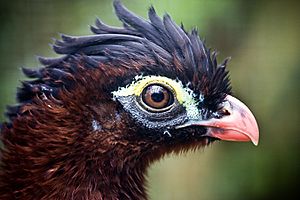Nocturnal curassow facts for kids
Quick facts for kids Nocturnal curassow |
|
|---|---|
 |
|
| Conservation status | |
| Scientific classification | |
| Genus: |
Nothocrax
|
| Species: |
urumutum
|
 |
|
The nocturnal curassow (Nothocrax urumutum) is a type of bird found in parts of South America. It belongs to the family Cracidae, which includes birds like chachalacas, guans, and other curassows. You can find this bird in countries such as Brazil, Colombia, Ecuador, Peru, and Venezuela.
Contents
About the Nocturnal Curassow
The nocturnal curassow is a special bird because it's the only one in its group, called Nothocrax. Scientists used to think it was part of another group, but new studies showed it's unique. It doesn't have any different types or subspecies.
What Does It Look Like?
This curassow is the smallest of its kind, usually about 50 to 57.5 centimeters (about 1.6 to 1.9 feet) long. One bird weighed about 1250 grams (around 2.75 pounds). Unlike most other curassows, which are mostly black, this one has beautiful reddish-brown and chestnut feathers.
It has a flat, dark crest on its head. Its belly is a light yellowish-brown, and the tips of its tail feathers are lighter than the rest. Its eyes are brownish-orange and are surrounded by bare skin that's greenish-yellow above and black below. The beak is reddish-orange, and its legs are gray.
Where It Lives
The nocturnal curassow lives in the middle and upper parts of the Amazonia region. You can find it in southern Venezuela, southeastern Colombia, eastern Ecuador, northeastern Peru, and western and central Brazil.
It likes to live in forests that are on higher ground (called terra firme forests) and also in forests that get flooded, either all the time or just during certain seasons. It often prefers flat, low areas, especially near blackwater rivers. These birds are usually found below 850 meters (about 2,800 feet) in height, but they have been seen as high as 1500 meters (about 4,900 feet) in Ecuador.
How It Behaves
Even though it's called the "nocturnal" curassow, this bird is active during the day too, as well as at night and during twilight. However, it only sings at night.
Feeding Habits
Nocturnal curassows look for food alone or in small groups of up to four birds. They usually forage at dawn, dusk, and for a few hours around those times. They search for food on the ground. It seems they eat only plants, but scientists haven't studied their diet in great detail yet.
Reproduction and Life Cycle
Scientists haven't figured out the exact breeding season for the nocturnal curassow. However, they have seen breeding activity between October and February.
These birds build large, loosely made nests from sticks and palm leaves. They line the nests with small twigs and dried leaves. Nests have been found high up in trees and vines, and also on stumps and logs close to the ground. A female curassow usually lays two eggs.
Vocalization
The nocturnal curassow sings only at night. It sings mostly on clear, dark nights when the weather is dry. Its song is a series of seven low, deep notes that sound like "hmm-hmm-hmmmm, hmm hmm-hmmm, hmmph!" Sometimes, several birds will sing back and forth to each other.
Conservation Status
The IUCN (International Union for Conservation of Nature) has listed the nocturnal curassow as a species of "Least Concern." This means that it is not currently in danger of disappearing. A large part of its home in western Amazonia is still untouched. Also, because it's mostly active at night, it might be hunted less often than other curassow species.
See also
 In Spanish: Pujil nocturno para niños
In Spanish: Pujil nocturno para niños


